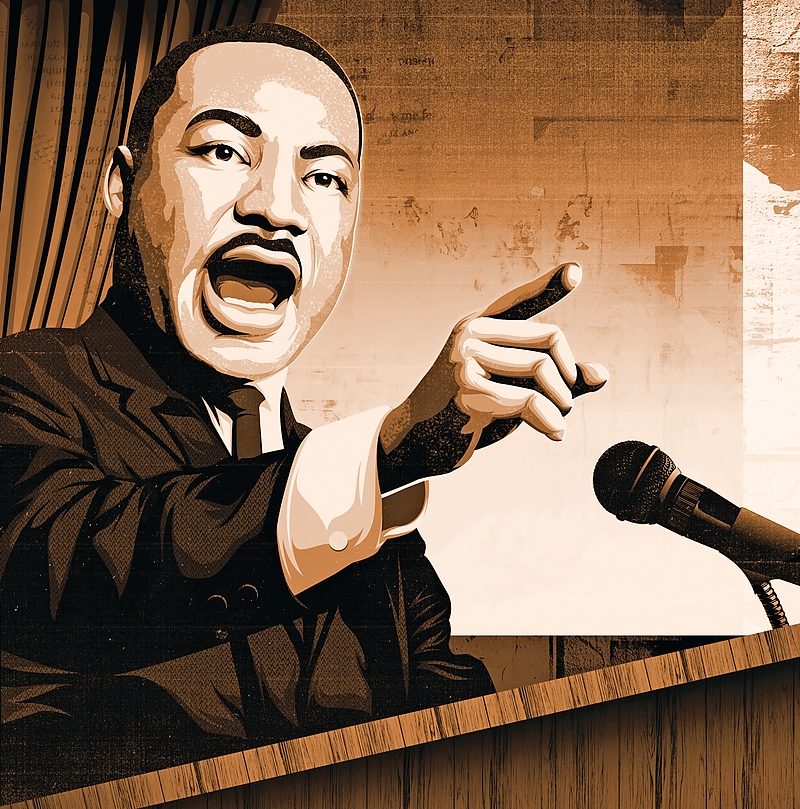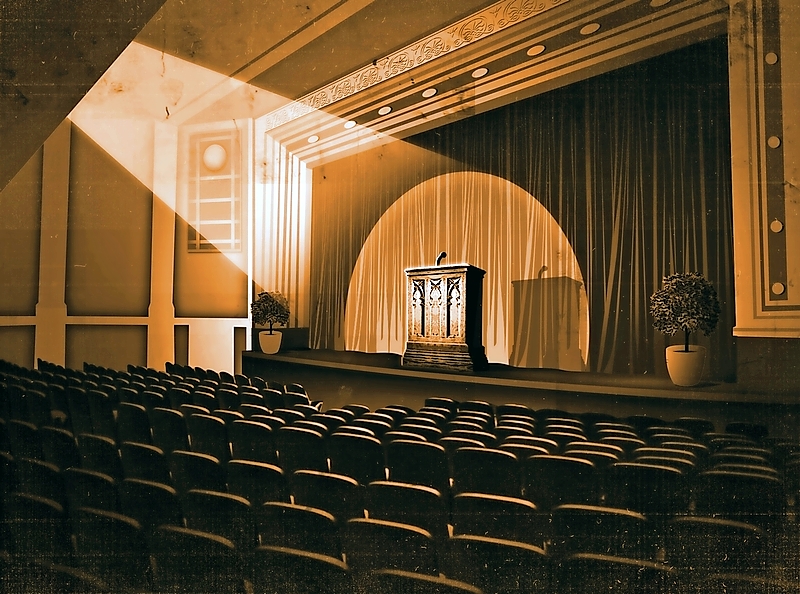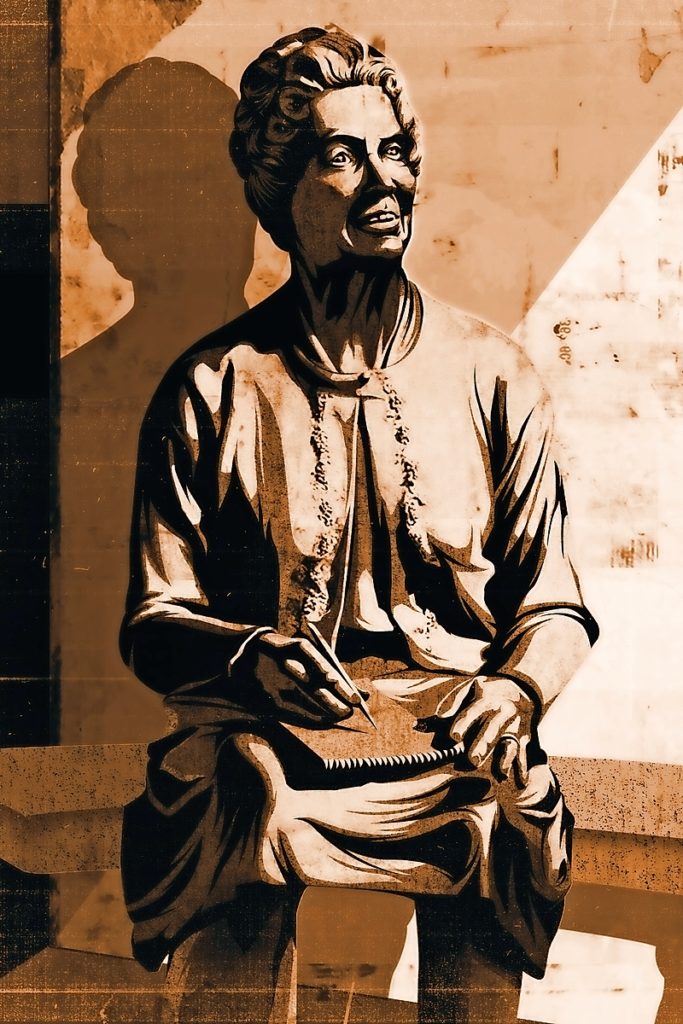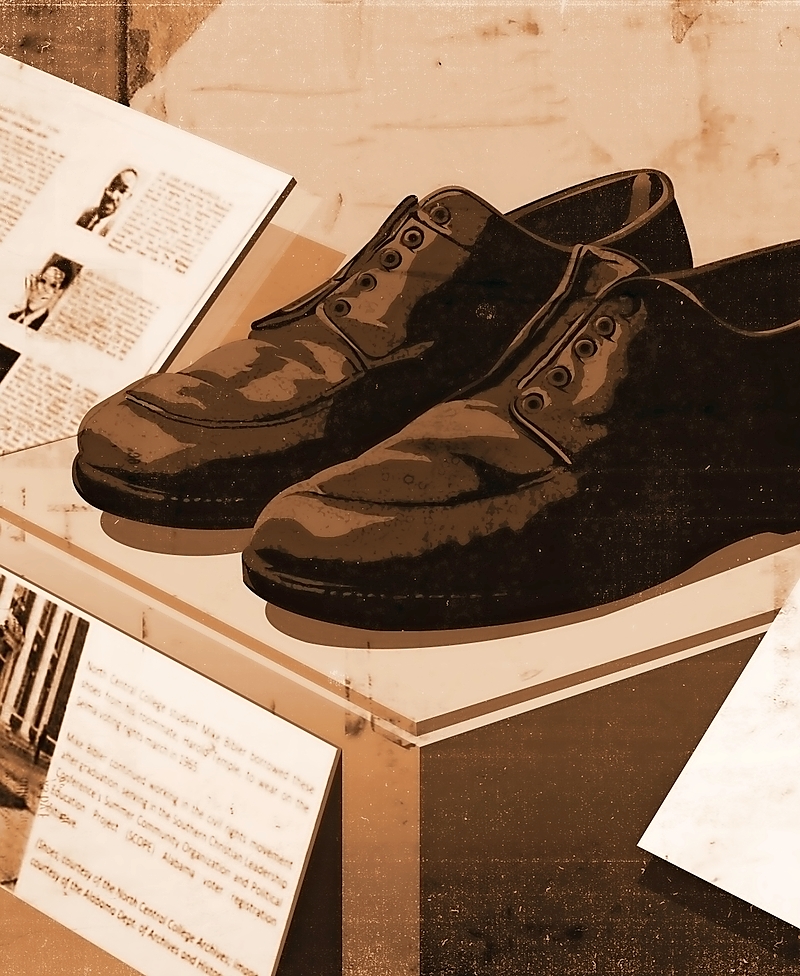Living Legacy
By Naperville Magazine
November 2020 View more Featured
This month marks the 60th anniversary of Martin Luther King Jr.’s speech to the North Central College community, a pivotal event in the ongoing work of Naperville residents at the forefront of the city’s civil rights crusade

Story by Dave Hoekstra
Illustrations by Taylor Callery
The city of Naperville was ready to take off in 1960.
More than 1,500 acres were annexed that year, marking the largest physical expansion in Naperville’s history. The city was beginning its shift from rural town to large suburb, both in geography and in mentality.
“I have thought about you and the North Central College community since I visited there some months ago. I will always remember the rewarding experience that was mine at that time.”
Martin Luther King Jr.
Harper Lee’s social justice novel To Kill a Mockingbird was released in 1960 at the same time locals were flocking to Cock Robin for a milkshake. Change was in the air. How would entrenched small-town minds respond?
On November 21, 1960, Martin Luther King Jr. visited Naperville at the invitation of North Central College’s chaplain. King had just been named co-pastor of his family’s Ebenezer Baptist Church in Atlanta and was president of the Southern Christian Leadership Conference, the Black minister–based organization that was at the forefront of the civil rights movement. He was a moral compass beginning to point north.
The invitation to speak was extended by Rev. George St. Angelo (1921–2012). Chapel service at North Central is no longer mandatory, but in the ’60s attendance was required, and St. Angelo arranged a variety of speakers at the services, including King.
The day began with a prayer breakfast. King, who was 31, was picked up from his Chicago hotel by George and his wife, Betty. While driving, St. Angelo told King about his school’s commitment to service and justice. King responded with a telling question: Would his children be admitted to North Central College?
King’s North Central speech was titled “Stride Toward Freedom,” and contained excerpts from his 1958 book of the same name in which he honored the nonviolent teachings of Gandhi and emphasized that Blacks be treated as equal citizens in the United States. Both the book and the speech were based on King’s experiences with the 1955–56 bus boycott in Montgomery, Alabama.
King spoke at an 11 a.m. prayer breakfast, then networked with North Central students in the afternoon. He delivered a second speech in the early evening at Pfeiffer Hall—a historic venue that still houses the podium from which King spoke. Another artifact from that day—a picture of King meeting the new North Central College president, Arlo Schilling—still hangs in the entrance of the school library.
Despite that documentation, Ann Durkin Keating, author and professor of history at North Central College, says there’s no archive of King’s speech at the school. “It was at the end of the term, and we don’t have a record of it,” she says. “We surmise [the speech] was for freedom. Martin Luther King is visiting white suburbia across the North in 1960–61, looking for support. And he’s getting it. It’s really King introducing the Southern civil rights movement. And he’s not [yet] well known.”
But King was known well enough that his visit to Naperville carried controversy with it. The college received threats about King’s appearance, including a letter from the Ku Klux Klan, but Schilling did not bow to public pressure. In a 2010 North Central historical retrospective, St. Angelo talked of the heightened awareness of the Naperville Police Department.
“They guarded the place where [King] took a nap, and when my wife and I drove Dr. King back into Chicago, they gave us a police escort all the way to Hinsdale. The point I’m making is, I don’t think they wanted [MLK] to come.”
Despite these circumstances, King remembered his visit fondly. Almost a year later, on September 6, 1961, King wrote a letter to Schilling. In part, he wrote, “I have thought about you and the North Central College community since I visited there some months ago. I will always remember the rewarding experience that was mine at that time.”

To understand the motivation of St. Angelo to bring Martin Luther King Jr. to Naperville, one first must understand St. Angelo’s background, as explained by Tina St. Angelo Wetzel—the middle of the reverend’s three children. George was a native of quaint Huntingburg, Indiana, where his father owned a men’s clothing store and was active in the local chamber of commerce. Brother Gordon (1927–2011), who also attended North Central College, was the chair of the Indiana Democratic Party and an early supporter of John F. Kennedy, then a senator. “The trajectory of what happened to Dad in his life started all this,” Wetzel says, referring to her father’s work. “His parents were involved in civil rights. When he was a boy his family had a cross burned on their lawn by the KKK.”
Unpredictable moments with more weight also changed Reverend St. Angelo’s life.
He joined the United States Army after graduating from North Central. St. Angelo was trained as a German translator in the Signal Intelligence Corps and was assigned to the 1945 liberation of the Dachau concentration camp, where he interrogated Nazi guards and administered medical care to survivors. Approximately 10,000 of the 30,000 prisoners were sick at the time of liberation.
“When he saw what he saw … ,” says Wetzel, as her voice trailed off, “… it totally changed his life. That’s when he went into the ministry.”
Reverend St. Angelo was ordained at North Central College in 1949, the same year he married his wife, Betty, after meeting her in the college’s library. Betty’s father was also a minister. After serving in northwest Indiana and Indianapolis, St. Angelo was named the first chaplain at the college in 1955. At the time, every North Central College student was required to take religion classes, and this commitment to spiritual teaching—including issues of justice—resonated with King. Up until his 1966 retirement from the ministry, St. Angelo invited others such as Henry Kissinger and journalists Eric Sevareid and Howard K. Smith to talk about social justice. Referring to these initiatives, Tina says, “North Central stuck their neck out.”

The Work that St. Angelo did at the college was singularly important, but perhaps even more impactful was the lasting legacy that he grew outside of campus—in Naperville, and in the surrounding communities.
Rev. Bob Burkhart was in attendance the morning of Martin Luther King Jr.’s speech at North Central. “It was impressive in terms of the spirit of dealing with injustice,” says Burkhart, now 81 and retired in Morton Grove. “It changed my life. My ministry was being shaped in his justice commitments that remain with me, but even stronger in these days of hatred and division. His spirit is with me.” During the 1960s, Burkhart participated in demonstrations as part of an ecumenical group advocating for justice in Lincoln Park. Between 1987 and 2007 he was pastor at Central United Methodist Church in Skokie.
King’s visit upset social norms in Naperville in more ways than one. In 1960 Naperville’s population was 12,000, and “it was overwhelmingly white,” says Keating. “There was no place in Naperville for him to stay.” In her 2018 story on MLK’s visit, Susanne Baker, a reporter for the Naperville Sun (a publication owned by Tribune Publishing, the publisher of Naperville magazine) wrote that King was chauffeured to a hotel in Chicago—he was not welcome to stay in Naperville, despite his invitation to speak there.
In the 1950s and 1960s, Naperville Sun columnist Genevieve Towsley (1907–95), a friend of the St. Angelos, wrote about race issues like these.
According to the 2008 book Naperville’s Genevieve (A Daughter’s Memoir) by Caryl Towsley Moy, the first column her mother wrote for the Naperville Sun in 1954 led to the integration of Centennial Beach. North Central hosted a conference that included free swimming sessions for participants, but Black conference participants were not allowed to swim at Centennial Beach at the time. Moy, who died in 2010, wrote, “The conference director called Mother to tell her about the situation. He asked if she had known about this policy. She had not, and was outraged.” Towsley contacted church pastors to attend a steamy City Council meeting in September 1954 about the policy. Moy wrote, “One member voiced his disgust that this Sun writer had the gall to tell Naperville government what to do.” But since no one in Naperville could produce a policy that prohibited Blacks at Centennial Beach, people of all colors were suddenly welcome to swim at the park district facility.
Historian Keating further explained Towsley’s influence: “Genevieve was forceful in writing about what students faced. There were African American students in the 1950s and 1960s. And they had a great deal of trouble in town. They had a great deal of trouble on campus. King’s visit somewhat tied into the transition of [North Central] presidents. The new president was interested in civil rights and Schilling supports Reverend St. Angelo. But he’s also working alongside people at the seminary. The college also begins to work for the first time with the pastor at St. Peter and Paul [Catholic Church]. Naperville then had a group of clergy who got together and began to address the fact there were no people of color living in Naperville.”
John Turpin was one of North Central’s Black students at the time, and is now a member of the North Central College Athletics Hall of Fame. A 1961 graduate, Turpin was a running back who was drafted by the Minnesota Vikings. A story headlined “Discrimination: An Unsolved Problem in Relationships of North Central, Town” appeared in the May 18, 1961, edition of the college newspaper. As one of a few Blacks on campus, Turpin told the newspaper, “If you are Negro, you can be anything you want as long as you keep your hands in your pockets.”
“It changed my life. My ministry was being shaped in his justice commitments that remain with me, but even stronger in these days of hatred and division. His spirit is with me.”
Rev. Bob Burkart
As a student-athlete attending a college at the forefront of civil rights discussions, Turpin and others were in uncharted waters. After an injury ended his professional football career, Turpin worked in television before receiving a master’s degree in economics from Stanford University in 1972. His career in the entertainment business included a stint as international tour manager for Janet Jackson’s Rhythm Nation tour from 1990 to 1992, a testament to his success despite racial obstacles.
Keating said, “From the late 1950s until 1965, George St. Angelo is really critical to this story. He encourages other people from Naperville to move into civil rights and join across the metropolitan area with others.”
A cultural pivot point for Naperville was the 1965 appearance of Freedom Ride organizer and Congress of Racial Equality director James Farmer at North Central College. Two weeks after his appearance, three busloads of students and Naperville-area residents left the college for Selma, Alabama, to support civil rights leaders in protesting voter discrimination. The road trip took place in the after-effects of the March 7 “Bloody Sunday,” when police attacked civil rights demonstrators with billy clubs and tear gas on the Edmund Pettus Bridge in Selma.
In the March 26 edition of the North Central college newspaper the Chronicle, student Cathy George quoted Farmer’s Naperville speech as the reason she jumped on the bus: “One can’t be neutral today … if you are a bystander you are not innocent … the greatest crime of all is the crime of silence.”
Wetzel said her father kept in touch with King occasionally, and he briefly spoke with him while in Selma. “Dad always said when he came to North Central the world was not on his shoulders yet,” she recalled in a conversation at a restaurant near campus. “When they met up in Selma in 1965, Dad said he was a changed person. He was not relaxed. People had high expectations for him.”
Reverend St. Angelo and the Naperville-area social justice warriors went to Selma and back in 48 hours. “They had to come back to school,” his daughter says. “In Selma, the FBI found Dad and said someone wanted to put a hit on him. But they still crossed the Pettus bridge.” The bridge was named after Edmund Pettus, a U.S. senator from Alabama and a leader in the Alabama Ku Klux Klan, according to Smithsonian Magazine.
Back in Naperville, St. Angelo gave a sermon on March 25, 1965, in the North Central College Chapel about the group’s experiences in Selma. He concluded, “One of our students was sitting on the ground as we were waiting for our buses to come home. A little girl came to him and asked if he was leaving. He rather shamefully said, ‘Yes, we have to go to Chicago, back to school.’ The little girl patted his head and said, ‘Thanks for coming,’ and leaned down and kissed him on the cheek. Joy abounds where love abounds. I don’t believe there is a superior race—but if there was one in Selma last Sunday, it was not white.”

The St. Angelos did not confine King’s dream of equality to the college campus. In January 1964, Betty and George St. Angelo, Rev. Richard Tholin (dean at Garrett-Evangelical Theological Seminary in Evanston), and Dick Eastman (a North Central College English teacher) met to establish a Fair Housing Commission in Naperville. The commission was established in 1965 and by April 1968—the same month of Martin Luther King Jr.’s assassination—a Fair Housing ordinance was sent to the Naperville City Council. It was voted down 3 to 2.
The committee’s work not only lacked city support—the members were threatened as well. “We had a swastika and the words ‘n—– lover’ spray painted on our garage,” Wetzel says. Tholin became part of a group of seven plaintiffs who sued DuPage County for promoting racial discrimination in housing, which resulted in Naperville becoming one of the earliest Chicago suburbs to create a fair housing ordinance. “I remember Mom and Dad going into Chicago all the time for NAACP meetings,” Wetzel says.
“I’ll never forget the day I saw a young Black boy riding his bicycle in Naperville with a little white girl on the handlebars. You’ll never know how happy that made me.”
Rev. George St. Angelo
Tina’s mother, Betty, played a pivotal role in this work, in both her home and community. Reverend St. Angelo was an avid reader who never learned to use a computer, so he wrote in longhand. Betty would type up manuscripts when needed. Her skills also benefited generations of Naperville high school students who knew her. She began work in 1968 as a secretary in the English department at Naperville Central, and in 1977 she moved to Naperville North, where she spent 20 years as secretary to the principal. She died in 2015 at the age of 91.
Because of their work here in the Chicago area, the St. Angelos’ vision of the civil rights movement became known across America. When North Central College hosted a 50th anniversary commemoration of King’s visit in 2010, acclaimed activist-author Cornel West spoke to a packed Pfeiffer Hall—just two years prior to Reverend St. Angelo’s death.
Between 1994 and 2014 Rev. Lynn Pries was college chaplain. He declared the West appearance as one of the best moments in his years of ministry. “Cornel said it was an honor to be in the same room as Dr. King had been,” Pries said. “And it was an honor to be in the presence of the chaplain [who] invited Dr. King. The audience voiced their appreciation with loud applause. George was beaming.”
After being introduced, West knelt on the stage to shake the hand of Reverend St. Angelo, who was sitting in the front row with his family. “He said, ‘This man had the courage and the vision,’ ” Wetzel recalls. “[Her husband] Steve and I got Dad up. The students and faculty paid for West to come. A group of girls sitting next to Dad shouted, ‘We didn’t know this was him!’ Do people know all this happened in Naperville?” St. Angelo quickly answered her question: “No, I truly believe that.”
“Dad was an optimist,” Wetzel continues. “At the 50th anniversary reception my Dad said, ‘I’ll never forget the day I saw a young Black boy riding his bicycle in Naperville with a little white girl on the handlebars.’ He said, ‘You’ll never know how happy that made me.’”
Every meaningful journey takes time.
A new path for Naperville was made in 1960. And today there is a renewed effort to find a place for everyone on a road where all dreams can take flight.
Dave Hoekstra is an award-winning Chicago journalist and a 1973 graduate of Naperville Central High School. He has written several books, including The People’s Place: Soul Food Restaurants and Reminiscences From the Civil Rights Era to Today. He wrote and coproduced the 2001 Emmy-nominated The Staple Singers and the Civil Rights Movement for WTTW-Channel 11 in Chicago.
LIVING LEGACY PANEL DISCUSSION
Naperville magazine editor and moderator Michelle Dellinger hosted a panel discussion centered around Dave Hoekstra’s feature (above) on November 16, 2020.
Event panelists included Hoekstra and the sources he interviewed:
• Rev. Bob Burkhart is a retired pastor who heard Martin Luther King Jr.’s speech when he was a senior at North Central College. Inspired by Dr. King’s speech, he became engaged in the civil rights movement in the ’60s and throughout his career became involved in additional issues of peace and justice.
• Dave Hoekstra is an award-winning Chicago journalist and a 1973 graduate of Naperville Central High School. He has written several books, including Reminiscences From the Civil Rights Era to Today. He wrote and coproduced the 2001 Emmy-nominated The Staple Singers and the Civil Rights Movement for WTTW-Channel 11 in Chicago.
• Dr. Ann Keating is an author and North Central College professor of history who provides commentary on the college community and national sentiments as the civil rights movement in the ’60s unfolded.
• Rev. Dr. Lynn Pries was the North Central College campus chaplain from 1994 to 2014, who was part of the 50th anniversary commemoration of King’s visit in 2010, featuring acclaimed activist-author Cornel West.
• Tina Wetzel is the daughter of Rev. George St. Angelo, the minister and chaplain who invited MLK to speak at North Central College, who discusses her parent’s civil rights work and the threats her family faced.
• Dr. Benny White is Naperville’s first African American city councilman, elected in 2017, who has been actively involved in the city’s diversity, equity, and inclusion initiatives. He is a West Point graduate and veteran and a former board member of Indian Prairie School District 204 and the Fire and Police Commissioners.


